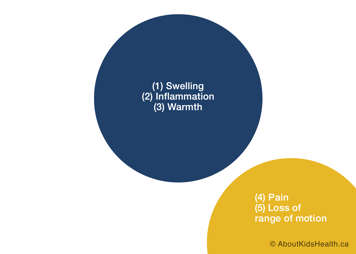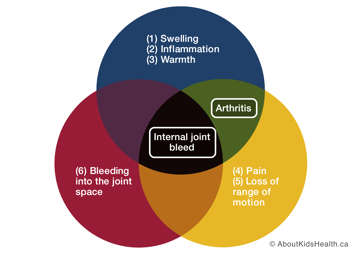Two common complications of joint disease are arthritis and synovitis.
What is arthritis?
When you have bleeding into a joint, it starts to swell. The joint can also become inflamed, which causes heat and pain in the area. Inflammation of a joint is called arthritis.
There are many causes of arthritis. In hemophilia, arthritis is caused by the irritation that blood causes in the joint space. This process can be around the time of bleeding (acute) or after the bleed is resolved (chronic).



If your doctor suspects that you may also have arthritis, they may advise you to take anti-inflammatory medicine in addition to clotting factor when you have an injury. You can avoid developing arthritis for many years by avoiding bleeds by complying to your prophylaxis regime, treating your bleeds early and following the RIICE first-aid treatment approach.
For more information, see the page on Supportive care: Using R.I.I.C.E. in Module 4: Managing bleeds.
Once you get a bleed in one joint, it is more likely that you will experience bleeds in the same joint. This is sometimes called a ‘target joint’. If not treated early enough, the increased inflammation eventually destroys the cartilage that surrounds the bones. When this happens, the bones can start to rub against one another, causing pain and difficulty moving.
What is synovitis?
Inflammation in the soft tissue that lines the joints (synovium) is called synovitis. Like arthritis, synovitis can also be acute or chronic. Acute synovitis is usually treated with supportive care (yes, this means you must rest!). Sometimes, doctors may use anti-inflammatory medicines to treat synovitis. If synovitis does not resolve shortly after the bleed (acute), it may lead to persistent symptoms.
Surgery to treat synovitis
When there is significant damage to the synovium, your doctor may suggest surgery. Removing the synovium decreases pain and swelling in the joint.
The surgical removal of the synovium is called a synovectomy. During a synovectomy, a surgeon physically removes the damaged synovium around the joint (arthroscopic). They do this by making very small cuts around the joint. Another option is a radio-synovectomy. During a radio-synovectomy a doctor injects radioactive material which slowly chews away at the synovium. A radio-synovectomy does not usually improve the function of the joint, but it will help to alleviate symptoms.
